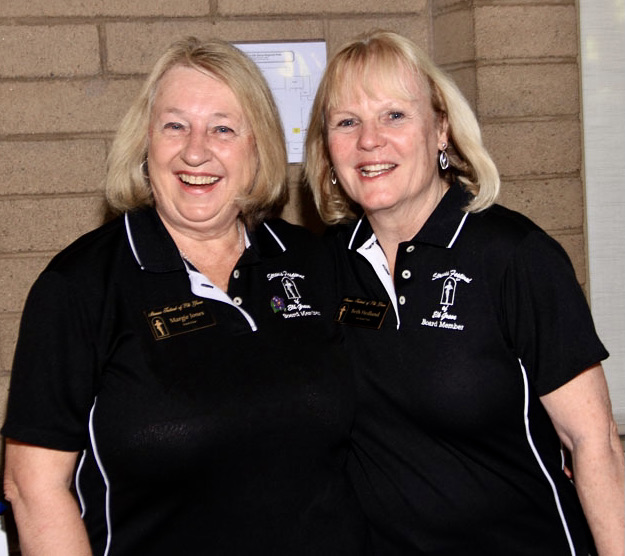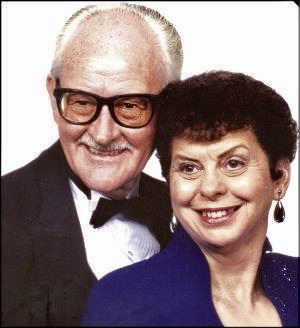
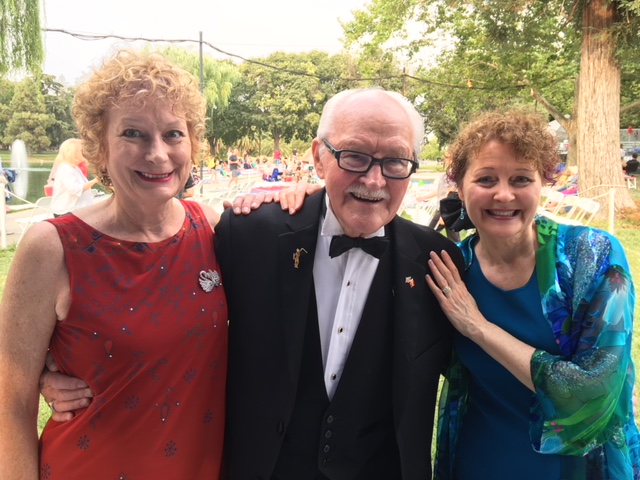
Note: Arnie graciously wrote the story we have all been asking him to, and its wonderful and interesting. In assembling this article to post, I have tried to gather photos of many of the things and people he mentioned to enhance the story, but unfortunately, I am limited to what I have been able to find. I am sorry that I don’t have photos of many of the movers and shakers he mentioned in his article, but I am searching to find them. Hopefully one day. I can represent everyone. Until that time, enjoy and appreciate what this couple has accomplished. If you have a photo of someone he mentioned, PLEASE contact the historical society so we can add and recognize them. Thank you, LOUIS
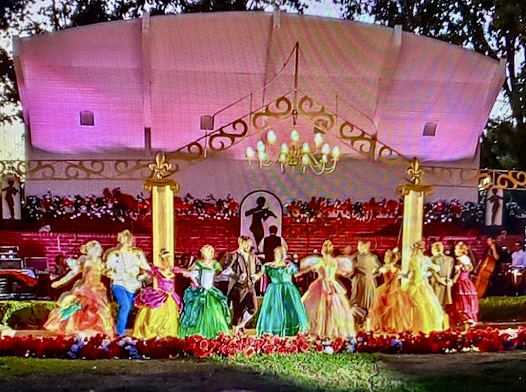
THE STRAUSS FESTIVAL OF ELK GROVE ~ (A Dream Come True) ~
By Arnie Zimbelman
Several people have suggested recently that I write a brief history of the beginnings of our rather unique Strauss Festival of Elk Grove. Since the passing of Iris in 2016, I seem to be one of the few remaining “survivors” with intimate knowledge of all of the problems, obstacles, and difficulties that had to be overcome to make that Festival the grand success it appears to have become. Therefore, please accept the following as my humble effort to help “keep the record straight,” as far as possible, at least from my own personal perspective.
What most people probably don’t know is that, had it not been for a very unfortunate small “accident,” there might never even have been a Strauss Festival. I realize that sounds a bit over- dramatic, so let me explain: some of you may not have known that Iris was an extremely avid and prolific reader, one who usually kept a stack of about half a dozen books piled on an end-table in our front room, with another stack on a nightstand in the bedroom for her later reading pleasure. (In fact, one of the most indelible “remembrances” of her youth was hearing her mother’s frequent command: “Iris, get your nose out of that book!”). We spent many happy hours with Iris sitting on the davenport reading one of her books while I sat nearby in my “reading chair” correcting student papers. When bedtime came, while I showered and went through my nightly routines, Iris would invariably already be in bed, propped up on pillows, continuing her reading.
Now, as to the “accident” that broke up this idyllic procedure: a visit to a Kaiser ophthalmologist revealed a small hole in the retina of Iris’s left eye. How it had developed we never really knew (though Iris always suspected it came about when, one day as she was cleaning, she sprayed Raid up into a cupboard and a tiny droplet fell back down into that eye). Whatever may have occurred, the result was that, after the retina had been repaired, the doctor insisted that Iris had to stop reading for about six months.
What to do now?? Six months without her beloved books? For Iris, any prohibition on reading was practically tantamount to a sentence of “death.” I remember well the many times she asked, “Now what am I going to do with myself?” A life without the ability to read, as far as Iris was concerned, was really no life at all.
Fortunately it seems, we had a trip to Europe scheduled for that fall, 1984. Our first trip overseas had been in 1975, to Greece, Egypt, and several Greek Islands in the Mediterranean, to commemorate our 25th Wedding Anniversary. We had made a second trip, a sort of “Grand Tour” of Europe, some seven years later in 1982, but it had included only a very brief “peek” at the Alpine regions (our real favorite, as it turned out), so the trip in 1984 was to concentrate almost exclusively on that area.
The trip turned out to be all we could possibly have hoped for, plus some “extras” we could never have foreseen or even imagined at that time. One of these was an included performance of the world- famous Passion Play in Oberammergau, Germany, commemorating the 350th Anniversary of its very first performance back in 1634. This viewing led me, many years later, to write my first historical novel, Recompense: Return to Oberammergau. Secondly, and far more significant for this discussion, it also provided the ultimate inspiration for Iris to found the Strauss Festival of Elk Grove.

As we moved from area to area, from village to village throughout the Alpine regions, Iris began to note something: each little town, no matter what size, seemed to have some type of musical group performing in the open air of the streets. Whether these groups were supported by the local municipality or were just playing “on their own,” we really didn’t know, but the rhythmic sounds, whether from an accordion band, a steel drum band, or whatever, added a pleasant atmosphere that tended to permeate and “set the tone” for the entire little town. In Iris’s mind, she evidently began to ponder, “Why couldn’t we do something like that back home in Elk Grove? We have great weather there, plus plenty of talented people. I’ll bet they would support similar musical performances.”
This thinking all seemed to come together when we finally arrived in Vienna, Austria. There our tour included an evening at the Stadtpark, where we were to witness a demonstration of the Viennese waltz while we also enjoyed some of Vienna’s famed pastry. It turned out to be a very pleasant but not really an exceptional evening, after what we’ve seen year after year at the local Strauss Festival. As we devoured our excellent Sachertorte, an “orchestra” of about a dozen musicians played Strauss waltzes in a small gazebo, while three couples danced out front, demonstrating the rather exaggerated style of the Viennese waltz. Then couples from the audience were invited to come down and join the dancers. However, our group got back on the bus instead for the ride back to our hotel. Even though this doesn’t sound terribly “inspirational,” the seed had been planted firmly in Iris’s mind.

Upon our return to the good old U. S. of A., I remember distinctly Iris sitting on the davenport near me night after night, unable to read but deep in thoughtful contemplation. Then one evening, she offered her proposal: “I’ve been thinking, Arnie. We have such great evening weather here in Elk Grove. Wouldn’t it be nice if we could have some type of musical event here too, like those we saw in Europe? I think the Elk Grove community would support something like that.” Of course I agreed, but when we got down to “details” such as what type of music would be most acceptable, or where performances could be held, etc., we began to realize the difficulties involved in a venture like that. However, it seems Iris had already figured out answers to at least some of those questions during her “thinking sessions.” Her suggestion was that we utilize the music of Johann Strauss, Jr., the “Waltz King” of Vienna, because of its very universal appeal. My personal favorite composer has long been Wolfgang Amadeus Mozart, but as Iris explained, “There are lots of Mozart Festivals and Bach Festivals, but I really don’t know of any Festivals anywhere that feature the music of Johann Strauss, Jr. Besides, his music, while still considered classical, is much “lighter” and more familiar, so I think it would be more appropriate for Elk Grove’s taste.” And as usual, Iris proved to be absolutely correct.
At that time, however, many in Elk Grove still seemed to prefer Western themes and music (which led to the old query, “Are you talking about Johann Strauss or Levi Strauss?”). From the very beginning and on through the years since, though, the people of Elk Grove have responded most favorably to the lilting melodies of the Strauss family.
Iris’s next step was to assemble a committee to help bring her “dream” to fruition. Again, she seemed to have given long and serious thought to these selections, and as she related happily many times later, “Not a single person said ‘No’!” This truly was rather incredible, since no one at the time knew exactly what a Strauss Festival really was or had any idea whether such a venture could be successful or not, yet they were willing to provide their talents to the effort. Thus, the “Magnificent Seven” came about!
Dick Lichtenberger, Elk Grove’s Citizen of the Year, with strong Rotary connections, agreed to serve as Vice Chair of the Board. (When Iris first called Dick to explain what she had in mind, his immediate response was, “Go for it!” This was precisely the type of encouragement Iris needed right then).
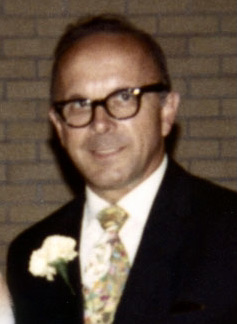
Marsha Holmes, former editor of the Elk Grove Citizen and an excellent writer, agreed to take on the challenging task of handling Communications for the new venture. Additionally, Marsha and husband Cy later, for a time, took over Iris’s rather arduous role of “chairmanship”’ following Iris’s “retirement” from the Strauss Board.

Sue Johnson, wife of Sacramento County Supervisor Toby Johnson, was recruited for the position of Community Liaison because of her many community connections. Sue was also soon chosen to be Chair of the Strauss Board of Directors, and she and Iris quickly became an unbeatable “team” in their dedication to the success of the Strauss Festival. (A quick “sidelight” on Sue: She later often repeated her initial reaction to Iris’s phone call. Sue said that, after agreeing to serve, she put down the phone, turned to Toby, and said, “This will never fly.” She didn’t yet know Iris!! In fact, Sue actually didn’t attend the first year’s Strauss performances, having gone to England instead to visit her son Jeff who was stationed there. We always had a sneaking suspicion, though, that Sue might have been afraid the Festival could be a total failure and thus an embarrassment to Toby. But once Sue became “committed,” you couldn’t possibly have found a more dedicated, more hard-working advocate anywhere.
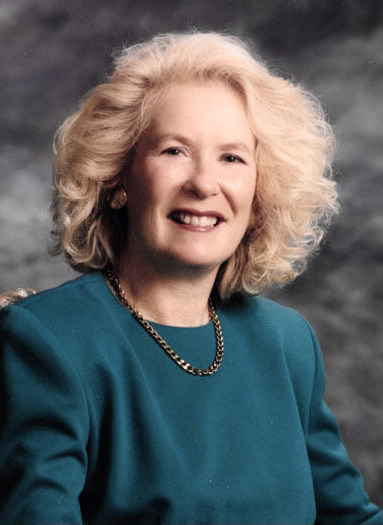
Jim Graybill worked at the local River City Bank, so Iris figured he would be a “natural” to serve as Treasurer of the Strauss Festival. The only problem was that the organization had absolutely no funds (which meant that, at least initially, Iris and I had to try to pay all expenses out of my rather meager teacher’s salary), but somehow Jim always managed to keep the Festival “solvent.” Jim was also an active member of the local Lions Club.
Linda Balkcom was a pretty across-the-street neighbor who had attended Brigham Young University. From Iris’s high school experiences, she knew that many members of the Mormon Church were skilled in dance, so she recruited Linda to be Director of the hoped-for show. Accepting was indeed an “act of faith” on Linda’s part.
Jay DeWald was at the time a music teacher and Director of the Elk Grove High School band, so Iris selected him to be Conductor of the yet-to-be-formed Strauss Orchestra.

Jay was also given the job of Music Archivist, which became ever more complicated as the various Strauss scores accumulated. I remember one occasion when a certain Strauss number had been selected, choreographed, and rehearsed (using only taped music, of course), but when it came time for Jay to obtain the musical scores for the orchestra, he found they were totally unavailable anywhere in the United States. Iris happened to know of a Johann Strauss Society in England, so very quickly she and Jay dashed off a letter to the English Society and sure enough, they did have the needed scores, copies of which they faxed to Jay, and the show went on! Additionally, for the early shows, Linda insisted that dancers could not perform for more than about five minutes without a rest. Jay literally spent hours cutting up his scores, which made things more difficult for both musicians and the Conductor. Fortunately, over time, this practice became unnecessary. Despite his lack of experience conducting an orchestra, Jay quickly won the respect of the orchestral musicians, and remained as Conductor of every Strauss Orchestra for thirty years, a truly remarkable record! He also became the longest-serving member of the original Strauss Board of Directors.


However, we still hadn’t solved the problem of just where any musical performances could be held, so that became the next issue to be resolved. Iris had pretty much determined that the Festival should be an open-air affair, preferably in a park setting similar to the Stadtpark in Vienna. Unfortunately, there was no such facility available at that time in Elk Grove Park. But for several years, we had been able to attend performances of the full Sacramento Symphony Orchestra held in the Park, sponsored by Roy Herburger’s Elk Grove Citizen, so Iris was determined to find a way to put on her Festival there as well.
We checked out every possibility we could think of in Elk Grove Park, including consideration of a “theater-in-the-round” under the beautiful oak trees where the Sacramento Symphony had performed, but nothing struck us as truly adequate. Iris met with Mr. Herburger and his friend Rev. Tony Ubalde (a member of the County Parks Board), but still without success. She also met with Gene Andel, then head of the Sacramento County Parks Department, and his assistant Ron Suter, as well as with Tom Oliver, who was in charge of the Elk Grove Park, and thus she also got to know Bill Fong, architect for the County Parks Department. The meeting eventually led to a suggestion from Mr. Fong: “Why don’t you use that little island in Elk Grove Park for a facility?” Thinking that he was referring to what was generally called Pirate’s Island, Iris immediately replied, “But that has all of the play equipment on it.” Mr. Fong’s response was, “No, I meant the other island,” referring to a second island we didn’t even know existed! Although Iris and I had ridden our bikes along the concrete walkway that encircled both islands many times, we had never even realized that the second area was a separate island, always assuming it was just an “abutment” attached to land on the other side. But, as Mr. Fong explained, it truly was a separate small island that had been designed by the original park architect, Walt Ueda, as a future site for an Elk Grove bandstand, but had since been pretty much neglected. Iris was intrigued by the possibilities.

It certainly didn’t take us long to check on Mr. Fong’s suggestion, and sure enough, there it was: a totally weed-overrun little plot of land, completely surrounded by the shallow waters of Elk Grove
Lake, with a rim of scraggly oak trees about eight or ten feet tall running along the back edge, and that was it! But in Iris’s eyes, the site was perfect for what she had envisioned!
So now the next step was to decide just what type of facility was needed, and equally important, to determine how its construction could be financed. This led to a series of evening meetings at our house, in which Iris was assisted by the then-head of the Parks Department of the Elk Grove Community Services District (our current CSD) Barbara (Morse) Wackford. In fact, Barbara’s overall assistance to the entire Strauss project was so essential, so vital, that at this point I need to digress momentarily to review a bit of her involvement.
It seems that, at some earlier time following our return from Austria, Iris had written a “Letter to the Editor” of the Elk Grove Citizen in which she had outlined briefly her idea for “Music in the Park.” Barbara had clipped the letter from the paper and pinned it to a wall in her office, indicating that this was a concept with which she agreed and one she would like to support, if it ever became feasible. She now became one of Iris’s most fervid supporters, usually working quietly but very effectively in the background. So when Iris set up a meeting with County Architect Bill Fong and Larry Stanfill, who at that time served as Stage Manager for the Sacramento Symphony Orchestra, Barbara also attended the meeting to offer her perspectives, since the planned performances and construction of a facility would affect her “turf.” Mr. Stanfill strongly advocated that the facility needed a bandshell to project the music outward so it could be heard by a larger audience. His idea was incorporated into the first architectural drawing of the proposed facility done by Mr. Fong, and it was that initial drawing that I used to build a small “model” of the facility, one which was displayed later at our first Strauss fundraiser as well as being utilized to help persuade the County Board of Supervisors to allocate finances for construction of a facility on the little island. Although a far different facility eventually emerged, that little model did serve as a useful visual representation of what Iris had in mind.
At the risk of making this whole account even more “fragmented” or disjointed, I need to interject something here that gave Iris’s “dream” more of a real sense of authenticity. That was the creation of the Strauss logo, since then trademarked and still regularly in use on any products associated with the Festival. The logo was the work of Barbara Douglas, who, along with writer Shirley Parenteau and Iris, had formed the Elk Grove Writing Group. In addition to being a writer, Barbara was also a talented artist, so now, after hearing what Iris had in mind and after studying a picture I had taken of the famed Johann Strauss, Jr. statue and arch in Vienna, she came up with the elegant little figure that soon became the symbol of the Strauss Festival of Elk Grove. And when a local paper products store offered Iris a ream of stationery headed by that logo, it really did begin to seem like the Festival was real. Incidentally, when Barbara first drew her “masterpiece,” as usual for an artist she “signed” her work by placing a small “B” near the heel of the figure of Strauss. Over time, however, as the picture was reduced in size, etc., that little “B” looked more like only a stray dot, and it was finally removed completely as a “clean-up.”
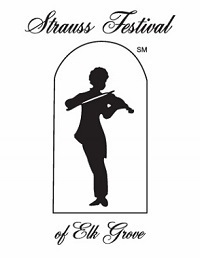
I also remember clearly another evening when I was invited to attend a Strauss meeting conducted in our back yard in the gazebo (or, more correctly, pergola). Jim Graybill’s then-wife Carol was also in attendance, and as we discussed ways to possibly “enhance” the Strauss logo to give it a bit more “body” on a wine glass, Carol suddenly said, “How about this?” Using a napkin as a ruler, she drew three lines of different length projecting from the logo and added the musical notes that still appear on every Strauss wine glass produced. And I guess we could say, “The rest is history.” But I do remember driving many miles out into the countryside later to deliver one of those wine glasses, a red ribbon tied to the stem, to anyone who contributed $25.00 to the Strauss Festival.
Enough “sidelights,” because we really still were quite uncertain as to exactly what we wanted our Strauss facility to look like. So Iris and I visited several areas where we knew community facilities already existed. One was in William Land Park, where I had once been responsible for holding the Elk Grove High School Commencement ceremonies, but it lacked any kind of dressing rooms, which Linda Balkcom, with her theatrical background, was wisely insisting must be included. The same “shortcoming” was apparent at both the facility in Marysville and in Oroville. So it was “back to the old drawing board.” and with more input from experienced souls like Linda (who also suggested wide double doors to enhance access to the dressing rooms in back), the present Strauss Island facility eventually emerged. I realize that over time and with the annual expansion of the cast the current facility has now become overcrowded and inadequate, but at that time (in 1987) we were delighted to have anything at all!
Of course, having plans and blueprints for a building was only the beginning. There still remained the rather formidable task of, “Now, how do we pay for having the thing built?” Here once again Barbara Wackford came to the rescue. She called Iris to inform her of a possible grant of County monies that might be available, money from what is called “Transient Occupancy Funds,” which basically comes from a special tax paid by anyone staying in a hotel or motel in the County of Sacramento. Iris was of course immediately interested; we’d had absolutely no idea that such a fund even existed, or of the possibility that this money just might be available.
There was only one serious problem in applying for those T.O. Funds, however: the absolute deadline for all applications was the very next day! But this was the type of “challenge” that Iris understood well, so it was time to get to work, without further ado. And with Iris typing furiously to complete the necessary application forms, while I worked on an appropriate cover to attract their “attention,” we made it! The result was a neat-looking three-color package that we were able to deliver in time for consideration.
One further factor made this entire procedure a bit different, as Barbara informed Iris: it seems that kind of by “tradition,” once a year the County Supervisors allow their “Aides” to recommend how to allocate the Transient Occupancy Fund money. What this meant was that, rather than Toby Johnson making the decision, it would be his Aide, Don Nottoli, who fortunately was also a long-time friend. However, we didn’t really know any of the other Aides, so Iris would have to be at her best as she made her presentation.
And that proved to be an advantage for us, because Iris’s presentation (at least in my opinion) was flawless. She not only extolled the virtues of “Music in the Park” which a Strauss Festival would bring to the south Sacramento County community, but she went on to tell how the proposed facility to be built could be utilized by the entire community for weddings or by other groups such as the “Sweet Adelines” for musical performances. What Iris didn’t know at the time was that one of the Supervisor’s Aides was actually a member of a “Sweet Adelines” singing group, and I’m sure this didn’t hurt when it came time for her recommendation. Additionally, Iris had persuaded Ray Bayles, who had recently opened his new silk-flower shop in Elk Grove, to donate five beautiful silk roses, which were passed out to the Aides, and I handed around the little model I had built of the proposed Strauss facility. Altogether, it seemed to be enough, because the Aides voted in favor of Iris’s project. And when it finally came time for the Board of Supervisors to vote at their next meeting, by what eventually became a unanimous vote (Illa Collin at first had voted “No,” until she realized the votewould be 4 to 1, so she switched), the Supervisors granted the Strauss Festival the sum of $100,000 to build a facility on what came ultimately to be known as Strauss Island. Needless to say, we were all ecstatic, and during the following days Iris received bouquet after bouquet of flowers plus dozens of other expressions of congratulations!
Before we stray too far from the contributions of Barbara Wackford, however, let me emphasize that her interest in and support of the Strauss Festival has never wavered in all of the years since its inception. Along with her husband, Don, the Wackfords have consistently supported all Strauss activities through attendance, financial support, and assistance (such as Don’s willingness to handle all wine sales at most events). Additionally,
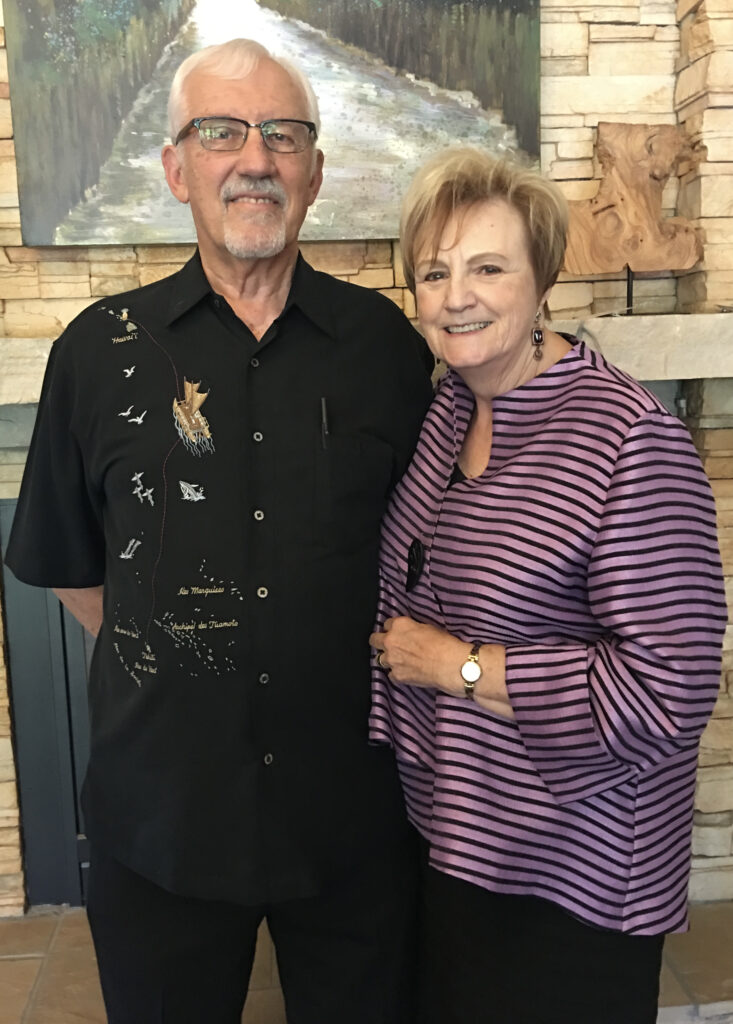
while she was still with CSD, Barbara was responsible for “convincing” various business interests and developers to contribute toward the acquisition and construction of the gazebo located near the entrance to Strauss Island, a structure that continues to serve as a sort of general “headquarters” during the actual Festival. And back in those very early days when Strauss funds came mostly out of our own personal budget, I remember fondly how Iris used to take items to be printed or copied down to the Boy Scout Building in Elk Grove Park, a section of which was at the time headquarters for the entire Elk Grove Community Services District, and there Barbara’s assistant, Pat Vincent, would run off the copies for us free of charge. This may not sound like much now, but at that time it was extremely helpful! And one further thing: as you travel around various parts of Elk Grove, please note all of the trees, shrubs, etc. that enhance our streets. That “beautification” came largely at as a result of pressure Barbara put on developers as Elk Grove expanded. Is it any wonder that the Wackford Center was ultimately named in her honor?
Now, back to actually building the current Strauss facility. Once funding had been received from the County, the next step was to obtain bids for its construction, hopefully within the limits of the available funds. Fortunately, at this point Jim Graybill’s connection to the Lions Club proved to be a major asset. As the bids began to come in, most were running well above the $100,000 amount approved by the County, but then a bid from DiBenedetto Construction Company arrived, listing a price in the $65,000

range, an almost unbelievable difference that some of the other bidders found hard to acknowledge. But Dan DiBenedetto was not only CEO of his construction company, he had also been elected President of the Elk Grove Lions Club, which enabled him to obtain promises not only of some free labor from fellow Lions but also some low-cost pricing on essential materials. As it turned out, any “left-over” monies were later utilized by the Lions the following year to build the arched bridge that still provides a graceful entrance to Strauss Island. Altogether, a most cordial relationship has remained with the Lions Club throughout the years, with the Lions eventually taking over all of the “parking duties” for the Strauss Festival, which is not a simple or easy task!
Meanwhile, we had also held our first Strauss “fundraiser,” perhaps designed as much as an “introduction” to what Iris had envisioned as to actually raise money, essential as that was. Anyway, Bob Lent, a local friend (and former student of mine, as was Barbara Wackford) volunteered his home located at what is kind of the junction of Hwy. 99 and Grantline Road, an offer Iris quickly accepted. Although we really had no funds with which

to advertise (I did make up a large sign with a red crepe paper border for our “Elegant Evening with Strauss,” but that was basically to provide direction; and I also built a small portable gazebo from which Iris sold tickets), evidently phone calls and word-of- mouth worked well enough to bring in a near-capacity audience. This was really a pleasant surprise to both Iris and me because we knew that none of the attendees actually knew what to expect from the evening, yet they were willing to plunk down $25.00 each, either out of loyalty or purely out of curiosity.
If you knew Iris, you would know that she was determined to make their evening worthwhile. It would also provide her an opportunity to “set a tone” for all future Strauss events: always “first-class,” dignified, with a positive atmosphere that left one feeling good. And even though it was never her intended goal, soon Iris herself came to personify all of those traits, as she gradually came to be seen as a living representation of the Strauss Festival itself.
For that first fundraiser, Iris wore a new wrap-around red dress with a big ruffle running down the front, and (at least in my opinion) she looked like the very epitome of “class.” In addition to a plentiful supply of elegant hors oeuvres prepared by volunteers (headed by Janet Hume, Sharon O’Hara, and Sophia Scherman), Iris had arranged for live classical music to be played by Jay DeWald’s brother Dale (flute) and his friend John (harp), with Dick Lichtenberger’s wife Ruth, an accomplished church organist, playing the piano during interludes. Once everyone gathered around the tables outside, Iris took over a microphone to make her presentation. I should mention that this was really the “scariest” part for Iris, who was not yet accustomed to public speaking, but she handled it with the “aplomb” we all soon came to expect. She introduced Bob Lent (with profuse thanks), and then briefly reviewed and explained her “dream” of a music festival featuring the works of Johann Strauss, Jr. which would be free-to-the-public so that everyone could enjoy classical music without being constrained by costs. The latter was always foremost on her list, because Iris and her six siblings had been raised by a single Mom during the depths of the Great Depression, when money for musical performances just wasn’t available. Yet she felt strongly that anyone could benefit from exposure to classical music, if that was the individual’s choice.
To complete the evening, with the help of Linda, Iris had procured a young couple, Wendy and Hiram, to demonstrate a Strauss waltz. Although there was no actual stage on which to perform, the beautifully costumed couple improvised by dancing on the back porch of the Lent home, receiving loud applause from the appreciative audience. It seemed that the “fundraiser” had achieved its goal!
Around Christmas time, we had another opportunity to raise some funds when Dianna Perham, who owned and operated a local art studio, donated a hand-painted “carousel pony” for a raffle held at the Park Pavilion. Once again our little gazebo served as a locale for Iris to dispense tickets, and we were pleased to acquire some additional monies thanks to Dianna and “Tony the Pony”.
Sometime after this, Glen Houde, who had served for many years as Superintendent of the Elk Grove Unified School District before retirement, told Iris he was planning to open an upscale restaurant, The Village Choice, in the Guttridge Center on Stockton Boulevard, and he would like to donate all proceeds from his “grand opening” to the Strauss Festival. This provided one more opportunity to tie the Festival to the local business community, so naturally Iris agreed, and soon had made arrangements with several musicians to play live classical music at the opening. However, construction delays intervened to cast the opening date into doubt. I remember well when Iris and I drove by the location the afternoon of the day slated for the opening, a pizza delivery truck was parked out front and we jokingly remarked that it looked like we might be serving pizza to the guests that evening. When we checked inside the restaurant, all was a jumble of plasterboard, copper pipes, and the general debris of construction.
But when we returned at dinnertime, we were absolutely amazed at the change. The whole place was immaculate! The forest-green carpeting, the nicely dressed young hostesses who greeted us, the over-all ambiance of the place was totally charming and inviting. What we didn’t know was that there had not even been time to test the ovens, etc., that would be essential to providing a dinner. Yet everything came off smoothly, without a hitch. It turned out to be a delightful evening, well supported, with a capacity crowd. It was events such as this that reminded us once again what great, loyal friends we had in Elk Grove! And Glen was equally pleased with the response to his new restaurant.
Now, after all of this “digression,” it’s time to get back to the actual building on Strauss Island. The first step, of course, is usually a “groundbreaking ceremony,” and for the Island this was also the procedure followed. On the appointed day, we all made our way to the little weed patch, either by jumping across the shallow water surrounding the island or by crossing on the temporary plywood “bridge” provided by the Elk Grove Parks Department. That plywood remained for the entire first show, and we were extremely fortunate that no one either fell or got hurt. Anyway, the ceremony turned out to be very nice, with brief speeches by Gene Andel, head of the County Parks Department (and a strong advocate of “music in the parks”), and by County Supervisor Toby Johnson, who had pushed hard for this facility in his south-county District. Iris followed in her usual gracious manner, and then the dignitaries took turns attacking the island weeds with shovels. Refreshments were served to conclude the ceremony, and now we were ready for the DiBenedetto Construction Company to go to work.

And this they did, almost with a “vengeance” it seemed, despite having to wait occasionally for Lions Club members to be available to help. Perhaps the best “visual record” of their over-all progress that we have available currently is a DVD that Jonesy Productions put together from a series of slides I took as construction progressed. The DVD was narrated by Chrisy Jones and is entitled, “A Dream Come True.” That seems to be a most appropriate title for what was now slowly unfolding, after all of Iris’s efforts.
If I may be allowed just one more “digression” at this point: I should mention that the County Parks Department did provide some nice “dividers” to separate the dressing areas for women and men in the new facility but didn’t install the units because they insisted it would require a “special wrench” to complete that job. As it turned out after I checked, that “special wrench” was only a simple Allen wrench, and since I had a full set of them, I decided to install the dividers myself …. and they’re still there! Also, much later Iris and I decided that the rather “barnlike” dressing area should be sheet- rocked, taped, and painted as well as carpeted to make it a bit more attractive and inviting. This was accomplished when friend Ray Gossovich of R & G Appliances generously furnished the carpeting material and with the assistance of a neighbor, Mr. Kloberdanz, who was an expert in taping and wall- plastering. After adding clothes racks, a long mirror, and Ray Bayles’s make-up table, the dressing room area has remained pretty much the same ever since.

Finally, though, the big day arrived when the new Strauss facility was complete and it was time for another ceremony: one of “dedication” this time. As it happened, this was also the same day that the initial Strauss Festival performance was scheduled to take place in the evening, so, while cutting it a bit close (truly an understatement!!), we really were delighted that “all systems were now ‘go.’” And the dedication came off very nicely, as well. In an attractive yellow dress (a color Iris normally did not like individuals to wear on stage because it tends to take attention away from all of the other performers, but which ultimately led Ray Bayles to believe she actually didn’t like the color), Iris handled the dedication responsibilities with her usual “class.” The program included brief remarks from both Gene Andel, County Parks Department, and Supervisor Toby Johnson, plus the presentation of a brass plaque to Dan DiBenedetto for getting the facility completed on time and within budget constraints. So now it was almost time for that very first Strauss Festival performance.
Here, everyone was operating in a kind of “no-man’s-land,” since no one was exactly sure just what a Strauss Festival production should look like. Iris evidently thought of that first Festival more in terms of a “variety show,” because the concept of a yearly topic or “theme” had not yet been introduced or considered (that would come later, when Betsy Knapp took over as Director). As it was, Iris seemed to be constantly on the lookout for any type of “talent” that could be incorporated into the Festival concept, and so it was that we got tickets one evening to an event whose name I don’t recall at all but where the “regulars” all played a kind of old-fashioned role as if they were from another era, speaking only in the stilted manner of the time period they represented, etc. It was here that we met a couple who pretended to be Russian royalty, and Iris soon convinced them that they should play that part in the inaugural Strauss Festival. And they proved to be real “hits” with the audience (I sometimes still have people ask about them) for the first two shows, until a divorce broke up the partnership.
There had still remained, however, the task of finding a competent dance troupe to perform the rather arduous, time-consuming task of choreographing, memorizing, and rehearsing the intricate steps of a variety of Strauss waltzes. To help solve this problem, Iris had put a notice in the local Elk Grove Citizen, scheduled tryouts at a local venue, then waited along with Director Linda Balkcom and Choreographer Betsy Knapp to see what the Elk Grove “talent pool” might produce.
Those first efforts proved to be a bit discouraging as far as waltz talent goes, and Iris was beginning to wonder whether or not her “dream” would ever be fulfilled. Then Mike and Gale Johnson showed up, and suddenly all perspectives changed. Mike had long been an electrician for the County of Sacramento, and Gale had been a very well-liked teacher at Pleasant Grove Elementary school; both had recently retired, and they did know how to dance! In fact, Iris made them kind of a “featured couple,” and they continued to grace the Strauss stage for ten years, serving as “dance masters,” teaching others, choreographing, doing absolutely anything necessary for the success of the Festival. Mike later became a most useful, trusted member of the set construction crew as well. On a personal level: while chatting over a delightful barbecue dinner at their home one evening, we discovered that Mike and Iris shared the same birth date, August 16, while Gale and I had birthdays only one day apart, January 10 & 11. This led to many years of mutual celebrations, frequently at some of the most “exotic” (or expensive!) places we could locate (such as The French Laundry, Chateau de Sureau, Brigadoon Castle, etc.). Both Mike and Iris are gone now, but the pleasant memories live on!
Now, back to that very first Strauss Festival. Eventually, a full contingent of dancers had been selected, and Betsy Knapp had performed her choreographic magic. Since the facility on the island was still under construction at the time, practices were generally held on the concrete slab across from Rhoads School. In addition to the waltz troupe, a lady from the Rancho Cordova Latter Day Saints Church, Dianne Jensen, had recruited and developed a young teen-age group of polka dancers at their church facility, and they quickly became a prime feature of the Festival. Volunteer seamstresses (led by Francis Fite, Dorothy Hrepich, and Mitzi Penney) came up with charming costumes for the Polka Kids (as they were called then), while Betsy took responsibility for costumes for the waltzers, along with her other duties. With practically no money to spend, Betsy became a true marvel of creativity, as she and Iris frequented the “dead and dying” racks of every fabric store they could locate to acquire material, which Betsy then managed to fashion into period costumes that always looked both appropriate and elegant.
As with any event, Iris knew that she also needed some type of printed program that would list the order in which the various dances would be performed, along with the names of the performers, etc. Here once again Iris was able to draw on the talents of a friend, in this case those of a lady named Nancy Barnett, who had recently joined the Elk Grove Writers Group. Much like Barbara Douglas who had created the Strauss logo, Nancy was a truly gifted artist as well as a writer, so Iris convinced her that she should create a picture that would capture the “essence” of what Iris was hoping to accomplish. And as expected, Nancy came through with “flying colors.” In fact, Iris was so pleased with Nancy’s work that Nancy ended up creating every Strauss program and poster for seven years, until she eventually moved out of the area. However, a “reminder” of Nancy’s talents remained displayed constantly in our home until the house was sold recently; it was a large sized “original” painting of one of those program covers (valued at $1500) depicting two young lovers, with the man affectionately touching the woman’s chin. Nancy presented this romantic painting to Iris after one of the Strauss Festivals, we had it beautifully matted and framed, and it hung in our front room above the stereo until the house was sold!
To serve as “Master of Ceremonies” for that inaugural performance, Iris wanted someone who would not only set the proper “tone” for the evening but who might also be an additional “attraction” for audience members.
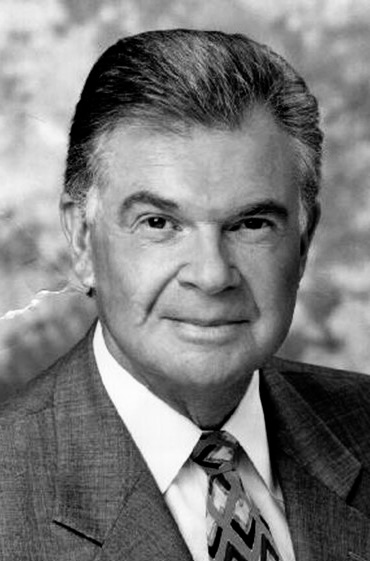
Her choice was Stan Atkinson of Channel 3, at the time perhaps the most popular and well-known TV anchorman in the entire Sacramento Valley (this was before Mark Hedlund, who is much younger, of course).

My reaction was, “You’ll never be able to get Stan; he’s much too busy,” but as usual Iris proved to be right! Once again, I had underestimated Iris’s persuasive powers (Sue Johnson used to refer to Iris as “An iron fist in a velvet glove,” someone who could convince almost anyone to do whatever it was she wanted or needed done). After a phone call to Channel 3, Iris turned to report, “I got Stan,” and although I was surprised, I guess I really shouldn’t have been, knowing Iris. Next, Iris recruited local attorney Hal Bartholomew to introduce Stan at the opening Festival, and we were on our way! I remember clearly a lady in the audience turning to her friend to remark, “I really came tonight to see Stan Atkinson,” so once again, Iris’s instincts paid off.
And following his introduction, Mr. Atkinson did his usual superb job — dignified, serious, but with just a touch of humor — to start the evening off right. This was followed by the waltz troupe, the “Russian” couple, and the Polka Kids, all performing flawlessly. I’ll never forget the impression made by the lady waltzers, in their new teal costumes, as they danced from the very back of the stage to the front, “flouncing” their skirts as they came to meet their partners. The audience absolutely loved it! But as has so often been the case, the biggest surprise and real “scene stealers” turned out to be the Polka Kids, with their daring, athletic antics that not only entertained but also provided a very nice “change of pace” for the program. The evening concluded with a delightfully choreographed “Beautiful Blue Danube” waltz, followed by the stirring “Radetzky March,” which Iris utilized for the “Curtain Call.” All in all, I don’t know of a single person who was sorry to have taken the time to attend that initial performance.
It wasn’t until sometime later that we read that it had actually been a “tradition” for Johann Strauss, Jr., to close all of his European performances with a rendition of “The Beautiful Blue Danube” waltz, always followed by “The Radetzky March,” played in honor of its composer, his father, Johann, Sr. And now, many, many years later, the tradition continues as we still end every performance at the Strauss Festival of Elk Grove with the same numbers.
That first Strauss Festival was scheduled to run for two nights, but Stan Atkinson’s work schedule had permitted him to commit to only one evening, so with the help of Jay DeWald, Iris was able to persuade radio personality Tom Nakashima (another former student of mine at EGHS) to take over MC duties for that second performance. Tom did a very

commendable job (even though indicating that his former teacher was still a bit “intimidating”), the previous program was repeated, and the evening’s performance ended with a small cast party consisting mostly of a congratulatory cake. To thank Iris for all of the work she had put in, I also presented her with a pretty ruby and diamond ring, a ring she really treasured until it was stolen later (but that’s another story). Iris also planned a rather special “thank you” for her Board members and spouses: brunch on the patio of the newly opened Village Choice Restaurant. It was during that brunch that I remember Toby Johnson calling Sue in England to report how well the entire evening had gone, how positive all of the responses had been, and that next time he wanted her to be there to experience it all. And I believe it was really from about that point on that Sue became such an avid Strauss supporter and worker. In fact, I’m not sure we could have evencontinued Strauss performances without Sue and her faithful pick-up to haul items from place to place!
During the days following the performances, Iris was almost overwhelmed by the outpouring of appreciation from members of the community, as bouquets of flowers and congratulatory letters arrived at our house. Among the most meaningful was a beautifully hand-written letter from Mary Tsukamoto expressing her pleasure and thanks for what Iris had initiated. The reason this meant so much to Iris is that she knew how difficult and painful the increasing arthritis in Mary’s hands made it for Mary to compose such a letter. Yet for many years following, the letters continued, becoming gradually more brief and maybe a bit less legible, until finally they ended with Mary’s passing. As happy as it made Iris to receive such accolades, though, this had never been her goal. She was still basically a deeply shy person and being thrust into the “limelight” always made her uncomfortable. However, what she did not want to happen (though several guys actually tried) was that someone else would try to take credit for coming up with what we all knew was her idea of a Strauss Festival.
That about sums up the first Strauss Festival, for better or worse. My personal role was always to be as supportive as possible, but never to try to impose my ideas either on Iris or on the show. In fact, Iris preferred that I not even attend their Board Meetings because of my tendency to “take over” or dominate such situations. She always tried to maintain an atmosphere of “openness,” where all felt
free to express their own opinions. And partially, I believe, she was also determined to demonstrate that a woman could actually come up with a new idea and could carry it out successfully without necessarily depending on male leadership to accomplish her goal.
This, of course, didn’t mean that I was ever totally “banished,” though my role tended to be more in the realm of producing various “sets” to enhance her shows. And I remember very clearly how hard Iris tried to incorporate an idea I had only vaguely suggested into one of her later productions. The idea was that the two leading “couples” would eventually switch partners, as they came to realize where their true interests and attractions lay. For whatever reason, I don’t think the concept ever came across clearly during the actual performance, but Iris was at least willing to give it a try!
Another thing we were constantly on the lookout for was dance talent …. not because our first group hadn’t done a remarkable job, but not all could return. And fortunately, after that first show, a number of very talented dancers did come to try-outs, among them Ray Bayles who insisted he would dance only if the “boss lady,” Iris, asked him personally. Iris was
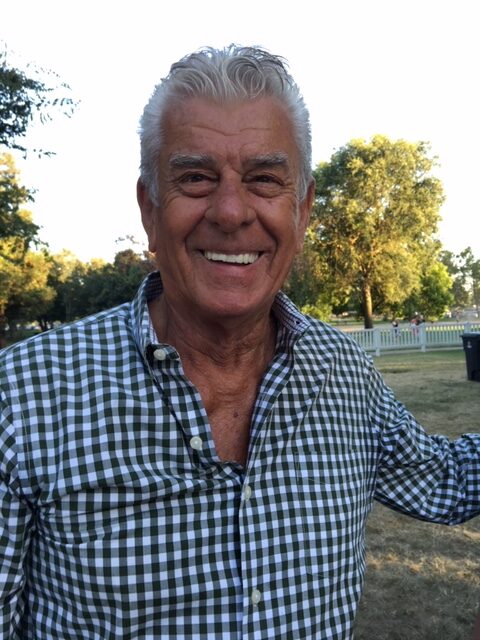
delighted to do so, and the result was that we acquired a premier dancer with all kinds of “hidden” talents, someone who graced the Strauss stage for the next thirty-plus years. Over time, many members of Ray’s family became involved aswell (including wife Carol as a member of the Strauss Board of Directors; daughter Raelynn, a terrific dancer who later agreed to take over from Ray the onerous duties of Producer; plus grandchildren Cody, Emma, and Jacob), all adding their distinct abilities to furtherance of the Festival in a wide variety of ways. There was also a group from the local St. Joseph’s Catholic Church, including the very talented Arnold family who played a major part through the years, as well as the Howard family, the Woltrings, and many, many others “too numerous to mention” (for fear of leaving someone out).
Another source of talent was the annual Black and White Ball put on by the Sacramento Symphony Orchestra as a fundraiser. It was here that Iris found dancers John and Laura Kosbau who had chiropractic offices in the north area but drove to Strauss practices for years to add their talents to the Festival. Actually, a large number of dancers drove great distances for long periods of time just for the privilege of being in the show, something Iris and I thoroughly appreciated even if we (as complete non-dancers) didn’t always understand.
Iris frequently indicated that her favorite “role” came in helping to select the music for each production. Starting with the second year’s production, when Betsy Knapp had taken over as Director of the show, a general “theme” or storyline was established and followed, but as long as Iris was responsible (as Producer for twelve years, and for at least one year, as both Producer and Director), her usual procedure was to (1) think up a complete “story” or concept, which she always took to the full Strauss Board for approval; (2) meet with Deborah (Arnold) Reno to choose the appropriate music and dances to tell the story; (3) then inform me what “set” items she would need to enhance the production. As the years went by, however, it became more and more difficult to come up with something new or different for a theme, and I remember well that almost every year Iris would inform me, “This is my last year. I just can’t do this anymore.” I didn’t argue or try to change her mind, knowing how difficult her role was. But invariably, after several nights of another successful Festival, Iris would wake me up during the night to tell me “Arnie, I just thought of a new show for next year,” and we were on our way once more. The only time I ever recall that total panic suddenly overtook Iris was the year she had agreed to serve as the show’s Director as well as Producer, because this was something just too far removed from her experiences. Fortunately, Deborah Reno agreed to assist her, and Iris survived even that traumatic situation.
As I’ve tried to indicate, my personal responsibilities always lay primarily in the area of producing the various “sets” Iris requested to enhance her story. Admittedly, these “sets” remained extremely simple for many years, for several reasons: I actually knew absolutely nothing about building sets, in addition to never having any extra money with which to purchase supplies, etc. The very first thing I remember putting together was a series of small trellises, only about a foot tall, painted white, that we placed along the front of the hedges planted at the back of the dance area. Along with a lighted Strauss logo picture up on the stage, that’s about all of the decorative devices we had available that first year.
In succeeding years, I did come up with one set/prop that seemed to impress everyone. That was for the year the theme was “Strauss on Tour,” and Iris said, “For Italy, we have to have a gondola.” On one of our trips, in Venice we had taken a midnight gondola ride with a singing gondolier, so I did have a vague idea of what a gondola should look like, but that’s still a rather far cry from actually building one. Still, if that’s what Iris needed …. Anyway, Iris knew someone (Marjean Ehlers) whose husband had an aluminum “John-boat” he used for fishing, so we drove to their house and borrowed the boat (which he eventually donated permanently to the Strauss Festival. Thanks again, Bob!!). So now my next job was to design and build a kind of plywood “shell” around the boat, add gondola-like end pieces, paint it all black, then work out a lighting system so that it could be seen after dark. The latter was accomplished when Bill Bumby, one of our Strauss dancers and also a Lions Club member, donated a converter (which we still have) plus the use of a battery. Iris added a “singing gondolier,” and the show went on. Through the years, though, that gondola has become a royal yacht, a “flower boat” with a canopy, in fact whatever the storyline required for a particular performance, as Iris always tried to take advantage of the island setting. Other than the boat, I remember putting together a couple of rather tall “windows” that Bill helped me attach to the front of the hedge area, but again there wasnothing elaborate.
It was also Bill Bumby who almost single-handedly built the original wooden deck attached to the back of the Strauss facility, later replaced by the current concrete deck. The deck provided both more space for the performers as well as more dressing area, particularly for the Polka Troupe. Bill, an electrician by trade, was also an excellent dancer and a superb choreographer. Additionally, the Lions had completed the arched bridge with its brick pillars, utilizing two beams that Iris had somehow heard about through the CSD. That bridge still constitutes an inviting “entrance” to Strauss Island (actually, at one point, Roy Herburger had promoted the name “Iris Island” in The Elk Grove Citizen, but County powers evidently over-ruled).

As for future set construction, however, everything changed rather dramatically after a phone call I received in 1992. The call was from Ed Keema, a local dairyman, whose daughter Kathy and friend, Delana, had previously volunteered to design and sew the costumes for the Strauss Festival. Ed indicated that he, and possibly his son, Mark, as well, might be interested in helping with sets for the Strauss Festival. I was absolutely delighted with his offer (especially since I partially misunderstood and thought Ed and Mark might actually be volunteering to take over total construction of ALL sets for the entire Festival performances, which was not really the case).

As it turned out, though, Ed’s offer could not have come at a more opportune time, leading to a rather spectacular shift in what we were able to produce as sets. Ed was a true genius in matters of both design and construction, as reflected in the home he built and in which they still live at the Keema Ranch on Eschinger Road. And in addition to his many other talents, Ed too owned a pick-up!
For that year’s Festival, Iris had settled on a theme set in the Prater Park in Vienna, a place we had visited on one of our trips, featuring a huge old-fashioned Ferris wheel. So rather naturally, Iris had
informed me, “We’ll need a Ferris wheel for this year’s show.” Now, I was somewhat used to working with items made from wood, but truthfully I could think of absolutely no way to put together a replica of a Ferris wheel made entirely of wood. This is where Ed’s versatility in working with all types of materials came to the fore. His response was, “We can do that. Why don’t we make the Ferris wheel out of metal pipe?” So that’s what we did. Ed’s genius also extends to the realm of mathematics, so I remember well how he figured out what the exact radius of our creation would be, which stood twenty- two feet tall. And next, Ed designed the plywood seats we built to complete our Ferris wheel,
But we still hadn’t come up with a system to make the wheel actually rotate. Again, Ed solved the problem. Somewhere he found a gearbox that could be powered by an electric motor he acquired from a Dairy Supply Store on Stockton Boulevard. To provide a way to add lights to the rotating wheel, we first asked Mike Johnson if the County electricians might be able to find a solution. But when they came up with a rather complicated gadget that we weren’t convinced would do the job, Ed simply pulled down a shop-light gadget attached to a beam in his shop, saying, “This should do it!” and the problem was no more. The lighted twenty-two foot tall Ferris Wheel proved to be quite a hit at that year’s Strauss performances.
What we didn’t know back then (1992) was that the very next year marked exactly one-hundred years since George Washington Gale Ferris, Jr., had invented his now-famous wheel for the World’s Columbian Exposition in Chicago in 1893. However, word seemed to have spread rather rapidly about our little replica, because calls kept coming for us to display our Ferris wheel: (1st) at the Sacramento County Fair; then (2nd) at the Amador County Fair; and finally (3rd) at the California State Fair, where a special platform was built in the Expo Center lagoon (at a cost of $2,000) for us to erect our replica. Hanging in his shop, Ed still has the large wooden sign thanking the Strauss Festival for our efforts.
That same spring, the year I finally retired from teaching after thirty-eight happy years in various classrooms, we came up with another item Iris had not even asked for. That was our Calliope Coach, which I’ve generally considered to be our most elaborate set, and once again it was truly a product of Ed Keema’s imaginative genius. It seems that Iris had convinced our son-in-law David Hirsch, a professional musician among many other talents, to play his electronic keyboard nightly at the Festival as a type of “prelude” to the performances. What we really needed was an appropriate venue for Dave’s keyboard. Ed and I kicked around several ideas …. mostly along the line of a three-sided folding tryptic-like device, but we hadn’t really settled on any single design.
That all changed when I arrived at the Keema Ranch the next morning. Ed had drawn a small picture of a cute little coach with wheels, etc., that just looked ideal for what we needed. The more we talked, the more we kept coming back to one question: could we possibly actually build something like that coach? Ed had acquired a set of iron wheels he planned to use for another project, and he now volunteered to lend them temporarily to Strauss. That’s all it took, and we were on our way!
Operating from a design that was mostly in Ed’s head and utilizing every spare scrap of wood we could scrounge at both of our places, we gradually constructed the present “Calliope Coach.” Through the years, it has not only housed Dave’s keyboard whenever he provided music for the Festival, but was also displayed at the Sacramento County Fair, at numerous Strauss events, and has been used countless times in Western Festival parades (usually filled with Strauss dancers dressed in full-costumed regalia). Our only current problem with the coach is finding adequate storage space, because of its size.
Moving on from these rather humble beginnings, the “Carney Coach Company,” as we came to be called, built a wide variety of stage sets, depending on whatever Iris said she needed for a particular show. Among these were two different castles, the first a more solid fortress-type that enabled
Deborah Arnold Reno to sprinkle fairy dust onto the stage from one of the turrets, and the second, a lighter, more airy Disneyland style castle for a later production. We also built a chalet (still often referred to as “The Music Box”) with a protruding balcony from which the “figurines” (actually, dancers Cheryl and Mike) escaped temporarily. I remember Iris later receiving a letter from Mary Tsukamoto telling us that, when the figurines finally returned to the balcony, with Cheryl now clutching a pretty bouquet of flowers, Mary cried. For other performances, we constructed a lighted Eiffel Tower (which the Sacramento Bee reviewer called “an exact replica”), an elaborate “Flower Cart,” a portable “Maypole,” a golden metal “Cinderella Coach,” and a replica of the “Gloriette” monument that overlooks the beautiful gardens behind Schonbrunn Palace in Vienna.
I do need to mention one more “creation” by Ed and me before we both finally reached “retirement age” from involvement with Strauss set-construction. That final item is the Swan boat. Once again, Iris and Deborah had dreamed up a rather mystical, esoteric theme for the year’s production, and came up with the idea of bringing in the entire Polka Troupe on a kind of magical boat shaped like a swan. Deborah’s then-husband Dave and friend Don Reno had even drawn up a rough sketch for building the boat on two canoes, but Ed had other ideas. Utilizing a wooden platform he had, Ed determined that we could attach large, sealed plastic pipe sections to the bottom as “floats,” and this worked out beautifully.
Next, we had to create a swan superstructure that didn’t look quite as much like a duck as the proposed one. To get a better idea of a swan profile, Iris and I followed the Schwann Ice Cream truck several times and then I drew what I thought a swan should look like on a piece of cardboard (it was actually an old “Toby Johnson for Supervisor” election poster). After completing a cardboard model of a swan boat, I took it out to Ed Keema’s, where we used it to create the plywood Swan Boat for the show (the scale was something like: one inch equals one foot). After attaching lights to outline the head, tail section, the rather massive wings, etc., it really was an impressive sight to see a “swan” appear from behind Pirate’s Island, propelled by a small trolling motor we had borrowed, with Polka Dancer Dustin Poore smoothly controlling its progress. When the boat arrived at the dock on Strauss Island and dancer after dancer exited from it, the audience actually cheered. Our Swan Boat seemed to be a success! In fact, many years later it was utilized as the “setting” for a surprise tribute to Iris and me for our Sixtieth Wedding Anniversary, with sixty red roses presented to us by Ray Bayles, Doyle serenading us with “Eidelweiss,” and even a minor fireworks show arranged by Don Wackford and Lyndon King to make it a truly memorable evening!



Here I need to mention another gentleman, almost as talented as Ed Keema, who also wanted to become involved with the Strauss Festival. His name is Ray Baxter, and at the time Iris met him he and then-wife Kathy owned and operated a wood products shop, “Wood Wonders,” out of their home in south Sacramento. Like Ed, Ray couldn’t really understand why everyone didn’t have the natural ability to do what they could do, but that’s another story. Anyway, Ray and Kathy came up with a beautiful, lighted exact model of the Schonbrunn (“Beautiful Spring”) Palace, for which Kathy even made a special trip to San Francisco to obtain the precise “Maria Theresa yellow” color of paint. The model has been displayed prominently at a variety of Strauss events, as well as at a Historical Society “Open House.” Additionally, Ray produced many other items (still in use!) for The Strauss Festival, including a pair of elegant thrones, lighted logo “collection” boxes, the current Strauss “Gateway,” decorative Johann Strauss cut-outs, and on and on. Although he has since moved to Oregon and has lost his Kathy, Ray (now remarried) still attends Festival performances when possible and continues to offer his services, whenever needed.
While mentioning helpful people, I would be totally remiss if I didn’t include what came to be our basic “set-up” crew for the Strauss sets. Ed and I usually built what was needed for that year’s show in his shop at the Keema Ranch. Then, as the Festival neared, we generally had only two or three days to transport everything to Strauss Island and get it set up for the evening performances. The short timeframe was partly because the Island was not available sooner and partly because the Strauss Board, always short of money, could not afford to pay for “security” for a longer period.
The entire set-up process would have been impossible without the help of our dedicated crew, comprised of Mike Johnson (now deceased), Dave Raulien, Vernon Vincent, along with Ed and me. Of course, there were a great many others involved at times as well, such as Mark Keema and Tim Rauser, but the crew of five had most of the responsibility. We usually started with an early breakfast at either the Cornerstone or Stagecoach Restaurants, and then worked diligently until dark getting things “in order.” I remember well a comment by Sue Johnson as she watched us trudge wearily across the bridge one evening with toolboxes clutched in our hands: “You guys look like the Seven Dwarfs coming home at the end of a long day!” Another “indispensable” helper was Cy Holmes, who served at various times as Flower Cart salesman, boatman, photographer (who created an actual puff of black-powder smoke as he took a photo), whatever was needed.
When it comes to “totally indispensable people,” however, perhaps no one should rank higher than Kirsti Cripe-Rauser, who is still deeply involved after these many, many years. Although in the earliest days of Strauss both Kirsti and husband Tim were still spending a great deal of time with the
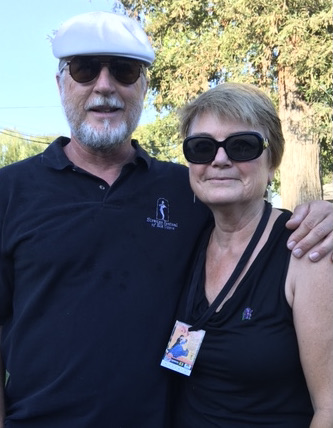
Elk Grove Theater Company, Iris could hardly wait to have Kirsti apply some of that theatrical expertise to Strauss performances. So when the Theater Company finally “hung it up” after performing at the Sheldon Inn, guess who was just waiting to put the genial couple right back to work? Kirsti’s unique theatrical “eye” provided the exact finishing touch that Iris had been looking for, and as the years went by, Kirsti’s role increased to include Director, writing an entire show, sewing costumes, in fact, doing absolutely anything and everything essential to the success of each year’s Strauss Festival performance. Tim’s duties have included the design and construction of a beautiful “gypsy coach” needed for a particular performance, as well as seemingly endless painting projects.
Another individual who worked mostly quietly behind the scenes for many years is Trayce Meany who not only danced and choreographed, but also, as owner of a local dance studio, offered her facility free-of-charge for Strauss practices at a most critical time. As with many others, Trayce’s role gradually “expanded” in order to take advantage of her numerous talents.
In addition to the many individuals who gave so much to the Strauss Festival, entire families have often devoted their time and talents over the years. Among these have been the Arnolds, the Bayleses, the Howards, the Matthewses, the Hinds, and the Sheryl Draper families. And with that, please allow me to offer my most sincere apologies, as well as my thanks, to all of the others that I’ve failed to mention …. dancers, backstage workers …. the list is practically endless. But every one of you is deeply appreciated, believe me!
Now, lest I’ve left the impression that everything always went smoothly during these “early days,” I need to state that there was considerable opposition to the entire concept, for whatever reasons, right from the beginning. Some came from a lady who was afraid the noise associated with the building process, etc., would scare off the ducks and ground squirrels who had inhabited the little island for years. Her letter of complaint to Supervisor Johnson might have doomed the whole idea if Toby hadn’t been wise enough to take a reading with an electronic monitor which proved the complaint to be facetious. Actually, the unrestricted proliferation of the ducks in Elk Grove Park proved to be the real problem, because for several years, with Park personnel approval, we held annual “duck round-ups,” with the captured creatures being relocated to a lake on the Perham property near Sloughhouse. There was also an effort by a local “gentleman of influence” to divert the Transient Occupancy Funds away from Strauss to build the planned Rotary Grove facility, as he told Iris, “You can always apply again next year.” It was during this exchange that I recall Dick Lichtenberger approaching me to say, “You’d better go help Iris.” My response was, “Don’t worry about Iris. She can take care of herself.” And that proved true, as Iris stood firm, and so did allocation of the funds. In time, both of these “opponents” became faithful attendees at Strauss performances.
I remember another evening very early in the entire process when Iris had attended a CSD meeting without me (I was probably home correcting papers), and Iris came home extremely discouraged, almost ready to forget the whole project because of the local opposition. As she reported the events of that meeting, it seems that a popular former Elk Grove Fire Chief felt it his duty to warn the audience of possible dangers inherent in construction of such a facility. “What would happen if there were a fire on the Island? Or if an airplane suddenly crashed onto it?” he posed. What really bothered Iris most was that not a single person in the audience rose to challenge or refute these rather far-fetched (if not ludicrous) queries, presumably either because of the perceived stature of the speaker or out of fear of contradiction.
But Iris wasn’t one to actually give up so easily on something she truly believed in. Rather, her response was, “Next time I’ll be ready for them.” Sure enough, at the next CSD meeting, she arrived accompanied by a cadre of loyal supporters able to answer any questions or respond to any ridiculous assertions. Among this group was CPA and long-time friend Stanley Carrothers who finished his remarks with the admonition, “Now let’s get crackin’!” Those words seemed to capture or characterize the attitude of the entire evening, and at least some opposition began to fade.
But then another group appeared,, more organized and more determined than ever. They all lived near Elk Grove Park and insisted that the facility would be built only, as a rather portly member put it, “over my dead body.” Despite their initial opposition, however, they were eventually “won over” either by Iris’s words or by her charm, and the leader of the group even volunteered to take on the somewhat arduous duties of handling all parking for the Festival, until his job required a transfer. And the man who had perhaps been most adamantly opposed at first came up to me later in a local grocery store to apologize for his opposition, stating flatly, “I was wrong!” I found his actions to be especially gracious and “uplifting” because such admissions are so rare!
On at least two occasions, also, the Strauss Festival was forced to take a “sabbatical” or leave of absence for a year (even before the restrictions imposed by the current corona virus situation of 2020- 21). The first time came because the Strauss Board had found it impossible to raise enough money to put on that year’s show, which Iris had always insisted must be “free-of-charge” so that nobody would be excluded. For the following year, the Sacramento Bee (who had always been very supportive of the Festival, even featuring Mike & Gale Johnson as dancers on the cover of their “Ticket” magazine one year), contacted Iris and volunteered to pay for the full Sacramento Symphony Orchestra, some sixty- four members, so that the show could return. And it did …. with the largest audience we ever had, an estimated forty-one thousand people. The only problem was that The Bee seemed to feel that now they could kind of “do as they please,” and came up with a plan to sell yellow T-shirts advertising the Festival. Naturally Iris resisted, because she felt that yellow T-shirts weren’t really a “classical” or dignified symbol and so would brand the Festival with the wrong image. The end result was that the Bee people withheld future support, a situation that seems to have continued right to the present.
The second time that Strauss performances had to be canceled came about seven years later and resulted largely from a dispute between Sacramento County and Elk Grove over the actual ownership of Elk Grove Park. This dispute was finally resolved amicably, and since then performances have gone on yearly under the capable direction of the current Strauss Board.
Over the many years, the Strauss Festival has come more and more to be an “accepted” part (in some cases almost a “representation”) of the present Elk Grove community. This is certainly a far cry from the days when Iris was extremely pleased with even the tiniest mention whatever of the Festival in any local media. But to illustrate the change, I’ll mention just two examples: the first was the cover of the phone book put out by Frontier Communications some years ago that showed Sacramento County, with a variety of symbols to represent different towns or areas within the county. For Folsom, the picture was of a rodeo rider; for Elk Grove, a violin. That certainly was quite a shift from the way Elk Grove had been traditionally envisioned. Next came something I had personally missed totally until our daughter Sherrie pointed it out to me. When the new Raley’s Store opened in Marketplace 99 in Elk Grove, inside the store all across the front was painted a large mural depicting Strauss Island and its environs. The store has since closed, but Iris’s “legacy” goes on and on …. hopefully forever!
A further example of just how much the influence of our Strauss Festival has spread came when Sunset magazine did a special feature on it, with a picture of Mike and Gale Johnson included. That article, in turn, brought a gentleman all the way from New York City to Elk Grove for a week to see if he might be able to replicate a similar program in his home city. His name was Bob January, and Bob had his own orchestra back in New York that especially played Strauss music, so he seemed to feel that a similar Festival should follow somewhat naturally. For the entire week that he was here, Bob attended practices, observed everything carefully, including actual Strauss Festival performances and the procedures for seating, etc., before coming to the conclusion that this whole procedure would be almost impossible in New York. As I recall his comment, it was something to the effect of, “Someone would steal all of those blankets in New York.” Once again, it provided verification that our rather unique Strauss Festival could happen “only in Elk Grove.”
This is not to say there have never been any problems in keeping the Strauss Festival concept alive in Elk Grove. Aside from the difficulties in raising the funds necessary each year to ensure Iris’s pledge of a Festival “free-to-the-public,” there have been hitches such as a lawsuit filed when a lady cut across the lawn despite announcements to “Please stay on the sidewalks,” stepped on a sprinkler head and twisted her ankle, then sued both Sacramento County and the Strauss Festival for “loss of conjugal privileges.” She won the lawsuit, which cost the Festival about $35,000.
Other problems have occurred due more to natural conditions, such as extremely hot weather. Normally this isn’t a concern, because our evening Delta breeze more often means you need a sweater or jacket instead. When Iris originally selected the dates for a Festival, she was more concerned about rainfall, so chose the last full week in July as the time least likely to get “rained out” (and at least to the present, she was right again!). I do remember a quick rainstorm hitting early one afternoon, but Iris and I were both konked out for a much needed nap at the time, and by showtime, all was well. But there was one especially warm day when the Festival came very close to being canceled. It seems that the Musician’s Union has a clause in their contract that prohibits them from playing when the temperature is above 95 degrees, for fear of damage to their instruments. On this particular occasion, the evening temperature held steady at 96 degrees, and the Union steward was ready to cancel the engagement. At the very last moment, however, a thermometer that had been placed on a chair on stage dropped to 95 degrees, and the show went on as planned. It seems Iris did have good “connections”!
So much for long-ago backgrounds. I hope this is at least somewhat helpful, even though there aren’t as many “old people” left to correct any errors or misconceptions I may have expressed as “facts.” I do have a tremendous amount of confidence in the current leadership and Board of Directors to keep Iris’s “dream” moving forward in the years ahead! Perhaps this information can provide them with a tiny additional spark of inspiration as they undertake their rather awesome tasks! If so, my efforts will have been worthwhile!
Still “just for the record,” it may be worthwhile to list those who have taken on leadership roles through the years after Sue and Iris relinquished their positions. Sue Johnson remained as Chair of the Strauss Board of Directors for ten years. At that point I remember clearly her telling Iris, “Look, we’ve had ten good years. Why don’t we just hang it up now?” Much as she hated to see Sue leave, Iris was convinced that Strauss performances could be supported and go on for a few more years, at least. So it wasn’t until two years later that Iris finally decided to “step aside,” and I really believe that if she hadn’t done so we would have lost her much sooner because of all of the stress and strain that can go with the job. And personally, I really didn’t think there was any way for the Strauss Festival to continue without Iris’s leadership and “personality.” I honestly expected the whole concept to just “fade away,” like the soldiers in that old military song. But Wow!, was I ever wrong!!
I guess I completely underestimated both the talents and the dedication or determination of either many people already associated with the Festival or new people who were taken with the idea and were willing to put in all of the effort essential to keep it going into the future. I am so happy to have been wrong in my assessment! I know the task has never been easy, but I’m so very appreciative of all those who have labored to keep Iris’s “dream” alive and well through the years! Thank you, thank you!!
(April 24, 2021)
THE STRAUSS FESTIVAL OF ELK GROVE
Following Iris’s “retirement,” the list of those willing and courageous enough to accept the responsibilities of Strauss Board leadership were:
1. Marsha Holmes
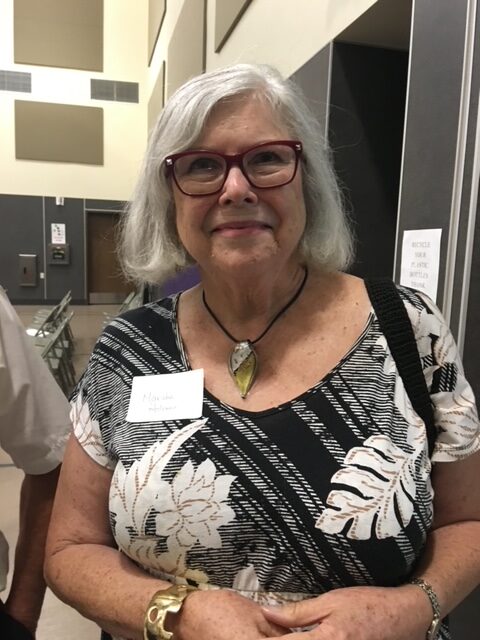
2. Mark Fetler
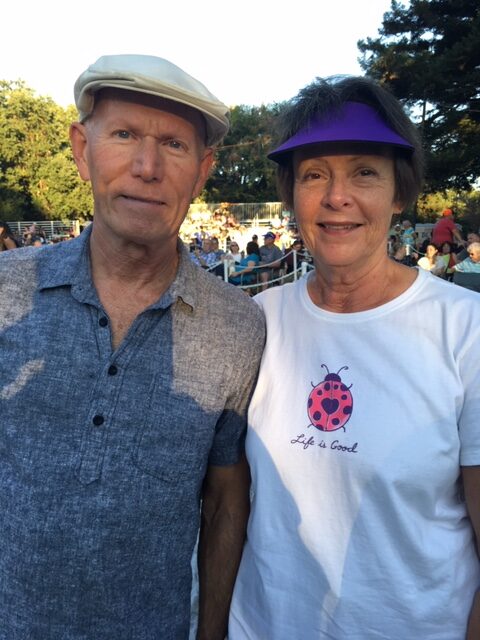
3. Don Wackford
4. Dr. Irma Greco
5. Co-Chairs: Dr. Jose Ramirez & Erin Kilbane
6. Stan Dunn
7. Cheryl Bray1
8. Marlene Sanborn
9. Jackie Lewis
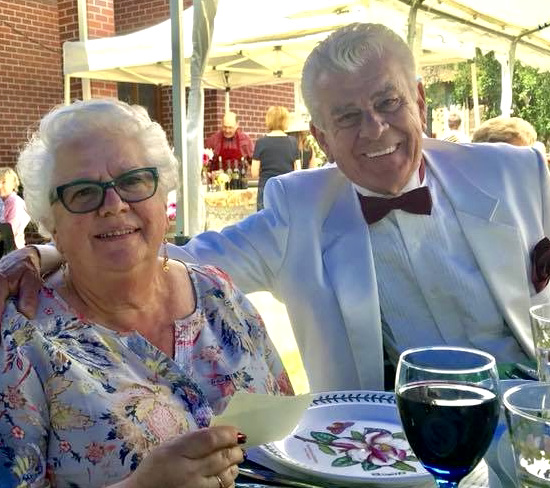
10. Millie Brink
11. Margie Jones & Beth Hedlund (current Co-Chairs)
